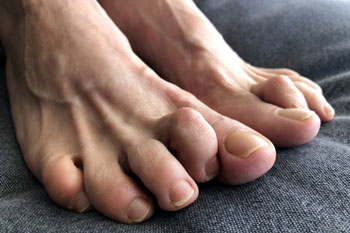
Hammertoes get their name due to the abnormal appearance of the toe, in which it bends down like a hammer. A hammertoe’s shape is formed by a deformed bending in the toe’s middle joint. There are many factors that play into how hammertoes form. Trauma to the toe, such as stubbing, jamming, or breaking it, can make the toe more susceptible to developing into a hammertoe. Age and gender also influence the likelihood of getting a hammertoe. Women have also been known to be more likely to develop a hammertoe compared to men. You’re also more likely to develop this condition as you age. Certain diseases, such as arthritis and diabetes, have been known to influence the likelihood of forming a hammertoe.
Hammertoes can be painful as well as incredibly uncomfortable. To help ease these symptoms, it may be beneficial to wear orthotics. Custom orthotics are used to help realign the toe structure and aid in the process of healing. Certain injections may be recommended by a podiatrist as well to help alleviate the pain. To prevent being afflicted by this condition, it’s recommended that you wear shoes that leave enough room for your toes and continually change your footwear as your feet change in size.
If you’d like more information on hammertoes and how to best treat the condition, we recommend you speak with a podiatrist for professional care and advice.
Custom Hammertoes Q & A
What are the symptoms of hammertoe?
Common symptoms of hammertoes include:
- Pain or irritation of the affected toe when wearing shoes.
- Corns (a buildup of skin) on the top, side, or end of the toe, or between two toes. Corns are caused by constant friction against the shoe. They may be soft or hard, depending upon their location.
- Calluses (another type of skin buildup) on the bottom of the toe or on the ball of the foot. Corns and calluses can be painful and make it difficult to find a comfortable shoe. But even without corns and calluses, hammertoes can cause pain because the joint itself may become dislocated.
Hammertoes usually start out as mild deformities and get progressively worse over time. In the earlier stages, hammertoes are flexible and the symptoms can often be managed with non-invasive measures. But if left untreated, hammertoes can become more rigid and will not respond to non-surgical treatment. Corns are more likely to develop as time goes on, and corns never really go away, even after trimming. In more severe cases of hammertoe, open sores may form. Because of the progressive nature of hammertoes, they should receive early attention. Hammertoes never get better without some kind of intervention.
What are non-surgical treatment approach options?
There are a variety of treatment options for hammertoe. The treatment your podiatric foot and ankle surgeon selects will depend upon the severity of your hammertoe and other factors. A number of non-surgical measures can be undertaken:
- Trimming Corns & Calluses
- This should be done by a healthcare professional. Never attempt to do this yourself, because you run the risk of cuts and infection. Your podiatric surgeon knows the proper way to trim corns to bring you the greatest benefit.
- Padding Corns & Calluses
- Shield corns from irritation. If you want to try over-the-counter pads, avoid the medicated types. Medicated pads are generally not recommended because they may contain a small amount of acid that can be harmful. Consult your podiatric surgeon about this option.
- Changes in Shoewear
- Avoid shoes with pointed toes, shoes that are too short, or shoes with high heels—conditions that can force your toe against the front of the shoe. Instead, choose comfortable shoes with a deep, roomy toe box and heels no higher than two inches.
- Orthotic Devices
- A custom orthotic device placed in your shoe may help control the muscle/tendon imbalance. Injection Therapy
- Corticosteroid injections are sometimes used to ease pain and inflammation caused by hammertoe.
- Medications
- Non-steroidal anti-inflammatory drugs (NSAIDs), such as ibuprofen, are often prescribed to reduce pain and inflammation.
- Splinting/Strapping
- Splints or small straps may be applied by the podiatric surgeon to realign the bent toe.
When is surgery needed?
In some cases, usually when the hammertoe has become more rigid, surgery is needed to relieve the pain and discomfort caused by the deformity. Your podiatric surgeon will discuss the options and select a plan tailored to your needs. Among other concerns, he or she will take into consideration the type of shoes you want to wear, the number of toes involved, your activity level, your age, and the severity of the hammertoe. The most common surgical procedure performed to correct a hammertoe is called arthroplasty. In this procedure, the surgeon removes a small section of the bone from the affected joint.
Another surgical option is arthrodesis, which is usually reserved for more rigid toes or severe cases, such as when there are multiple joints or toes involved. Arthrodesis is a procedure that involves a fusing of a small joint in the toe to straighten it. A pin or other small fixation device is typically used to hold the toe in position while the bones are healing. It is possible that a patient may require other procedures, as well-- especially when the hammertoe condition is severe. Some of these procedures include skin wedging (the removal of wedges of skin), tendon/muscle rebalancing or lengthening, small tendon transfers, or relocation of surrounding joints. Often patients with hammertoe have bunions or other foot deformities corrected at the same time. The length of the recovery period will vary, depending on the procedure or procedures performed.
